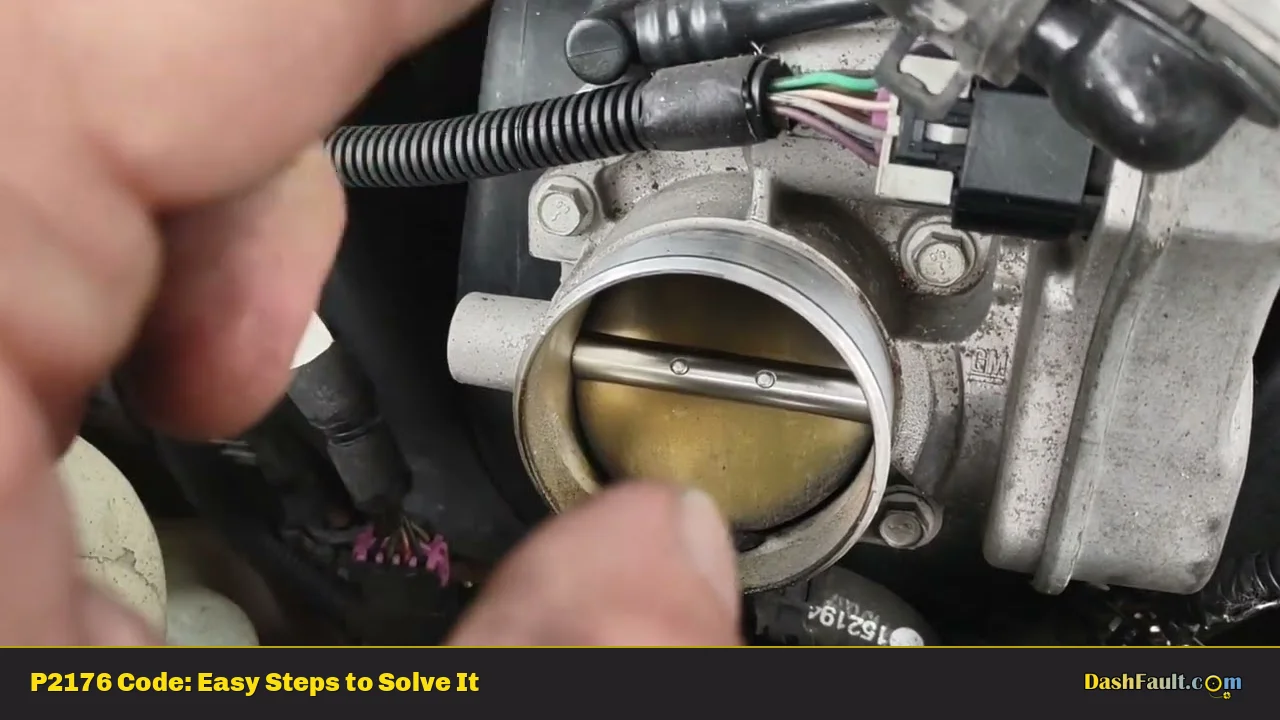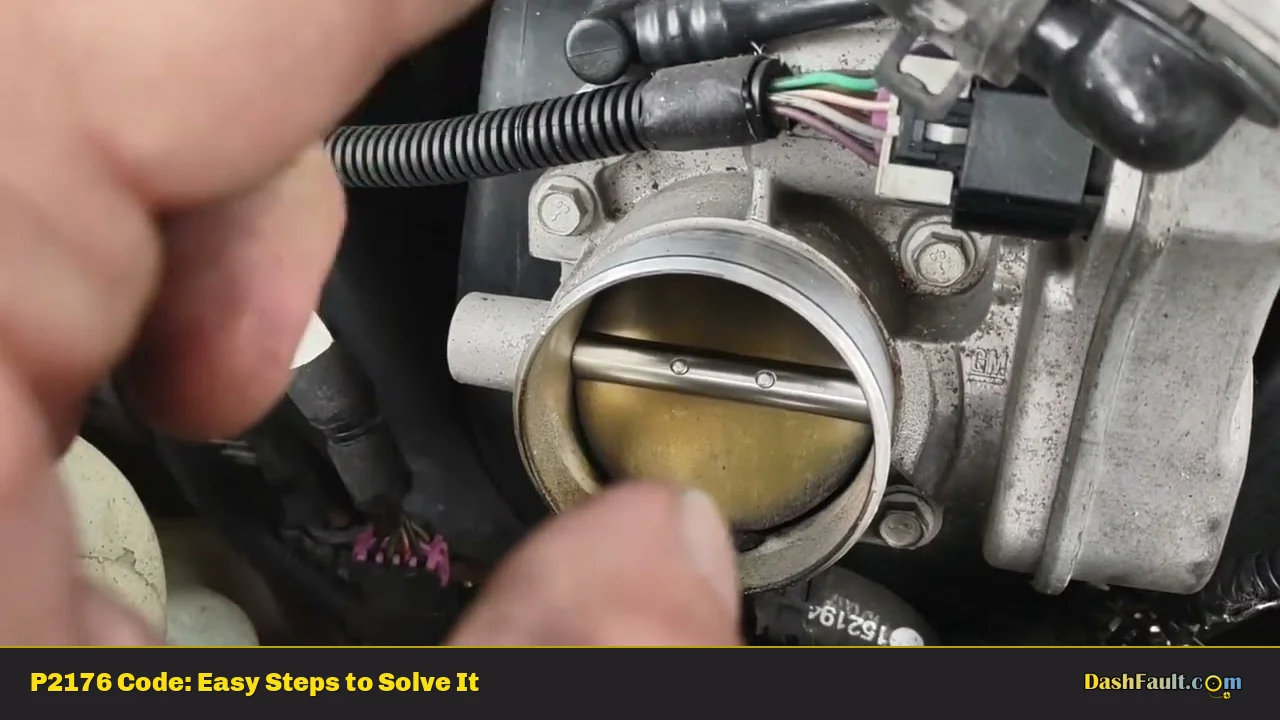The P2176 diagnostic trouble code (DTC) is a generic powertrain code related to the throttle actuator control system. This code indicates that the engine control module (ECM) or powertrain control module (PCM) has detected an issue with the idle position learning process in the throttle actuator control system. When this code is present, it means the vehicle’s computer is unable to properly calibrate or “learn” the correct idle position for the electronic throttle body.
| P2176 Code Meaning | P2176 Code Common Causes |
|---|---|
| Throttle Actuator Control System – Idle Position Not Learned | Faulty throttle body or throttle position sensor |
| ECM/PCM unable to calibrate idle position | Damaged or corroded wiring in throttle control circuit |
| Electronic throttle control system malfunction | Carbon buildup in throttle body |
| Idle speed control issue | Failed idle air control valve |
| Drive-by-wire system error | ECM/PCM software glitch or programming error |
Symptoms of P2176 Code
When the P2176 code is present, vehicle owners may experience a variety of symptoms that can affect drivability and performance. It’s important to recognize these symptoms early to prevent further damage and address the issue promptly. Common symptoms include:
- Illuminated check engine light
- Rough or unstable idle
- Stalling at idle or when coming to a stop
- Hesitation or stumbling during acceleration
- Reduced engine performance
- Engine may enter “limp mode” with limited power
- Difficulty starting the engine
- Increased fuel consumption
In some cases, the symptoms may be intermittent, making diagnosis more challenging. However, even if symptoms are not consistently present, it’s crucial to address the P2176 code to prevent potential damage to the engine or related components.
Technical Explanation of P2176 Code
The P2176 code is specifically related to the throttle actuator control system’s inability to learn or calibrate the correct idle position. In modern vehicles equipped with electronic throttle control (also known as drive-by-wire), the throttle plate is controlled by an electric motor rather than a mechanical linkage to the accelerator pedal.
The ECM/PCM uses input from various sensors, including the throttle position sensor (TPS) and accelerator pedal position sensor (APPS), to determine the appropriate throttle opening. The idle position is a critical reference point for the system, as it affects fuel economy, emissions, and overall engine performance.
When the vehicle is started, the ECM/PCM performs a series of self-tests and calibrations, including learning the idle position of the throttle. If this learning process fails or produces results outside of the expected parameters, the P2176 code will be set.
Several factors can contribute to this learning failure:
- Mechanical issues with the throttle body, such as carbon buildup or a sticking throttle plate
- Electrical problems in the throttle control circuit, including damaged wiring or poor connections
- Faulty sensors, particularly the throttle position sensor or accelerator pedal position sensor
- Software glitches or outdated ECM/PCM programming
- Issues with related systems that affect idle speed, such as the idle air control valve or mass airflow sensor
Step-by-Step Diagnosis of P2176 Code
Diagnosing the P2176 code requires a systematic approach to identify the root cause of the idle position learning failure. Follow these steps to diagnose the issue:
- Connect an OBD-II scanner to the vehicle’s diagnostic port and retrieve all stored codes and freeze frame data. Note any additional codes that may be present alongside P2176.
- Clear the codes and perform a test drive to see if the P2176 code returns. If it doesn’t, there may have been an intermittent issue or a one-time glitch in the system.
- If the code returns, inspect the throttle body for signs of carbon buildup or physical damage. Clean the throttle body if necessary, using an appropriate throttle body cleaner and following manufacturer guidelines.
- Check all wiring and connectors related to the throttle control system, including those for the throttle position sensor and accelerator pedal position sensor. Look for signs of damage, corrosion, or loose connections.
- Use a multimeter to test the voltage and resistance of the throttle position sensor and accelerator pedal position sensor. Compare the readings to the manufacturer’s specifications.
- Perform a visual inspection of the throttle actuator motor and linkage for any signs of wear or damage.
- If equipped, check the idle air control valve for proper operation and clean or replace if necessary.
- Use a scan tool with advanced capabilities to monitor throttle position, accelerator pedal position, and other relevant parameters in real-time while operating the vehicle.
- Attempt to perform the idle learn procedure using a compatible scan tool, following the manufacturer’s specific instructions for your vehicle model.
- If all physical components appear to be in good condition, consider updating the ECM/PCM software if updates are available for your vehicle.
Solution Methods for P2176 Code
Once you’ve completed the diagnostic steps, you can proceed with the appropriate solution based on your findings. Here are some common solution methods for the P2176 code:
1. Throttle Body Cleaning and Calibration
If carbon buildup is present in the throttle body, a thorough cleaning may resolve the issue. Follow these steps:
- Disconnect the battery to reset the ECM/PCM.
- Remove the air intake duct to access the throttle body.
- Use a throttle body cleaner and a soft brush to clean the throttle plate and surrounding areas.
- Reassemble the air intake system.
- Reconnect the battery and start the engine.
- Allow the engine to idle for several minutes to complete the idle learn process.
- Clear the code and test drive the vehicle to ensure the problem is resolved.
2. Wiring and Connector Repair
If you’ve identified damaged wiring or corroded connectors, repair or replace them as necessary. Pay special attention to the throttle position sensor and accelerator pedal position sensor connections.
3. Sensor Replacement
If diagnostic tests indicate a faulty throttle position sensor or accelerator pedal position sensor, replace the affected component with a high-quality OEM or equivalent part.
4. Throttle Body Replacement
In cases where cleaning and calibration don’t resolve the issue, or if mechanical damage is present, replacing the entire throttle body assembly may be necessary. Ensure you select the correct part for your specific vehicle model and engine.
5. ECM/PCM Software Update
If no physical issues are found, check with your vehicle manufacturer or a dealership to see if there are any software updates available for your ECM/PCM. Updating the software may resolve programming-related issues that prevent proper idle learning.
6. Idle Air Control Valve Service
For vehicles equipped with an idle air control valve, cleaning or replacing this component can help stabilize idle speed and potentially resolve the P2176 code.
Cost Estimates for P2176 Code Repairs
The cost to repair issues related to the P2176 code can vary widely depending on the root cause and the specific vehicle model. Here are some estimated cost ranges for common repairs:
- Throttle body cleaning and calibration: $50 – $150
- Wiring repair: $100 – $300
- Throttle position sensor replacement: $150 – $400
- Accelerator pedal position sensor replacement: $200 – $500
- Throttle body replacement: $300 – $1000
- ECM/PCM software update: $100 – $200
- Idle air control valve replacement: $150 – $400
Note: These are estimated ranges, and actual costs may be higher or lower depending on your location, vehicle make and model, and labor rates. Always obtain a detailed quote from a reputable repair shop before proceeding with repairs.
Warnings and Recommendations
When dealing with the P2176 code and related repairs, keep the following warnings and recommendations in mind:
- Never attempt to manually manipulate the throttle plate on an electronic throttle body, as this can cause damage to the throttle actuator motor.
- Always disconnect the battery before working on electrical components to avoid short circuits or electrical shocks.
- Use only OEM-approved cleaning products when servicing the throttle body to prevent damage to sensitive components.
- If you’re unsure about performing any of the diagnostic or repair procedures, seek the assistance of a qualified professional mechanic.
- After repairs, always clear the codes and perform a thorough test drive to ensure the issue is fully resolved.
- Regular maintenance, including periodic throttle body cleaning, can help prevent issues like the P2176 code from occurring.
Conclusion
The P2176 code, while potentially causing noticeable drivability issues, is often resolvable with proper diagnosis and targeted repairs. By following the steps outlined in this guide, vehicle owners and DIY mechanics can effectively troubleshoot and address the root causes of this throttle actuator control system error. Remember that proper maintenance and prompt attention to check engine lights can help prevent more serious and costly issues down the road.
Frequently Asked Questions About P2176
- Can I drive my vehicle with the P2176 code present?
While you may be able to drive short distances, it’s not recommended to continue driving with this code present. The vehicle may enter limp mode or experience performance issues that could be potentially dangerous. - How long does it take for the idle learn process to complete?
The idle learn process typically takes a few minutes to complete. However, some vehicles may require specific driving conditions or a set number of key cycles to fully complete the process. - Will a P2176 code clear itself?
In most cases, the P2176 code will not clear itself. The underlying issue needs to be addressed, and the code must be cleared using an OBD-II scanner after repairs are completed. - Can a weak battery cause a P2176 code?
While a weak battery is not a direct cause of the P2176 code, it can interfere with the ECM/PCM’s ability to properly learn the idle position. Ensuring your battery is in good condition is part of proper diagnosis. - Is the P2176 code covered under warranty?
Coverage depends on your vehicle’s specific warranty terms and the cause of the issue. Some manufacturers may cover throttle body-related issues under powertrain warranties, while others may not. - How often should I clean my throttle body to prevent P2176 issues?
As a general rule, cleaning your throttle body every 30,000 to 50,000 miles can help prevent carbon buildup and related issues. However, consult your vehicle’s maintenance schedule for specific recommendations. - Can aftermarket performance modifications trigger a P2176 code?
Yes, certain aftermarket modifications, especially those that affect airflow or engine management, can interfere with the throttle control system and potentially trigger a P2176 code. - What’s the difference between P2176 and other throttle-related codes like P2135?
While both are related to the throttle system, P2176 specifically indicates an idle learning issue, whereas P2135 typically indicates a problem with the throttle position sensor circuit or its correlation with the accelerator pedal position sensor.

